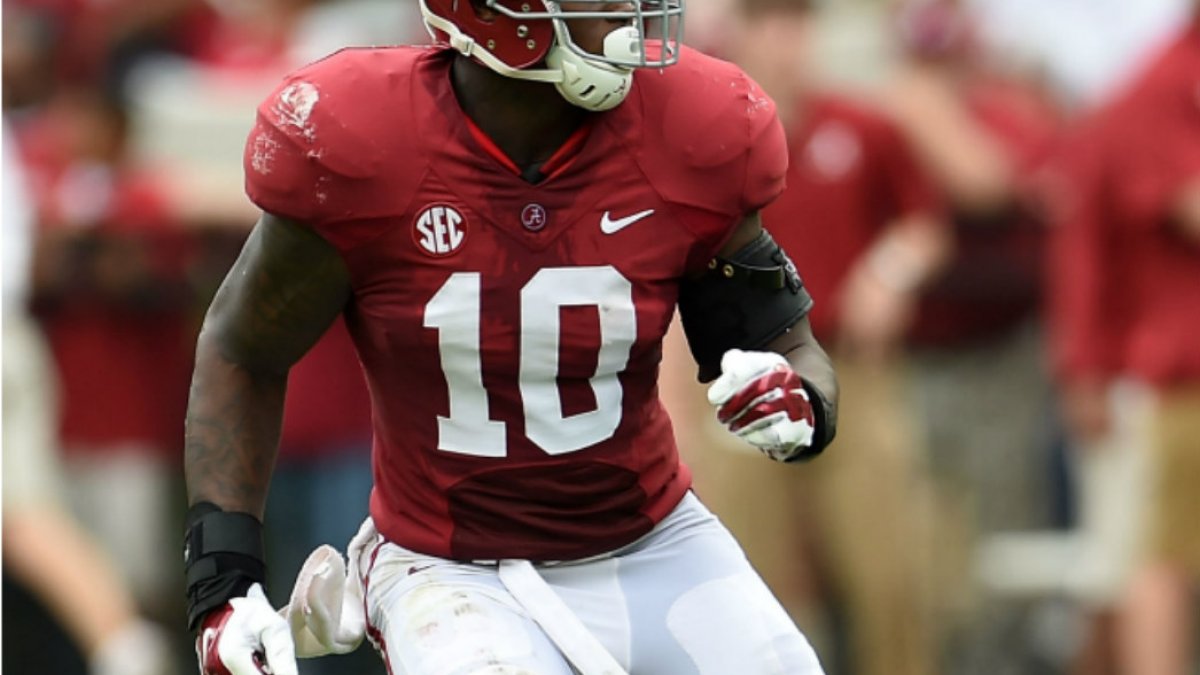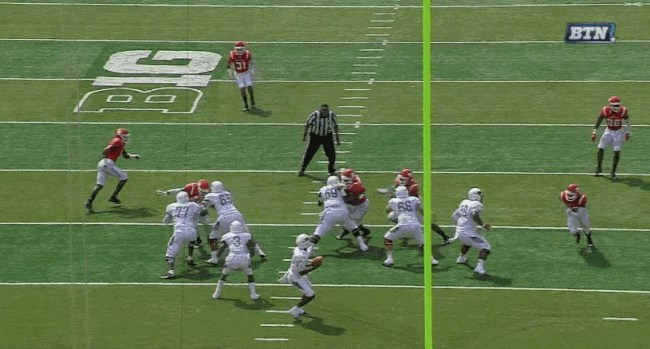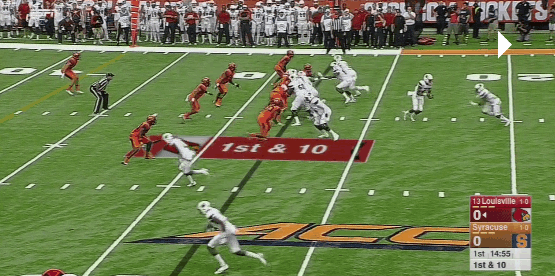With ten weeks of college football play in the books, numerous players have made big strides and improved upon their 2015 season grades. Today, our conference analysts are pinpointing which players have made the most progress this year from every conference in the country.
SEC
LB Reuben Foster, Alabama
Most improved doesn't just have be a player who has struggled in the past developing into a viable starter, and in Foster's case it's about him taking that next step from a very good player a year ago, to one of the elite players in the nation this year. Foster has made a tackle resulting in a defensive stop on 14.9 percent of his snaps against the run in 2016, up from 9.5 percent in 2015, while his missed tackle rated has improved from one miss every 9.6 tackle attempts, to just one every 20.5 attempts this year.
C Frank Ragnow, Arkansas
Like Foster, Ragnow hadn't played poorly before this season, but has elevated himself into the upper echelon of offensive linemen in the nation with his play this year. Outstanding in the running game, Ragnow has been our highest-graded center as a run blocker, doing a fantastic job sealing defensive linemen at the point of attack and also at the second level and on pull blocks against linebackers. Playing center this year he has a pass blocking efficiency rating of 97.6, compared with 96.5 at guard a year ago. Ragnow has kicked inside from guard, and grown into the top center in the nation right now.
CB Derrick Baity, Kentucky
Baity struggle in limited duty as a freshman last year, giving up a reception on 68.2 percent of this passes thrown into his coverage, but has shown a marked improvement in 2016. This year he has allowed a reception on 54.5 percent of targets, down almost 14 percent from a year ago. After failing to record a single interception or pass breakup last year, he has now recorded two interceptions and five pass breakups so far this year. Finally, his production at the position has increased, and after allowing an average of 1.53 yards per coverage snap in 2015, he has seen that drop to 1.16 in 2016. He might not be a top cornerback yet, but with such a big improvement in 2016, he's on his way.
— Gordon McGuinnes
Big Ten
OG Jordan Roos, Purdue
Roos was on our list of most underrated Big Ten players last week, and is the obvious choice to headline this week’s most improved list. His overall grade of 51.0 last season barely got him into the top 300 at his position, but this year through nine weeks he is at 86.7 and ranks fourth in the country.
In 407 pass block snaps he has given up just eight total pressures (one sack), compared to 23 on 580 reps in 2015. His run blocking has also been significantly better, as he ranks seventh nationally in the category.
ILB Tegray Scales, Indiana
In 486 total snaps last year, Scales had an overall grade of 59.4 and accumulated 22 defensive stops on 44 solo tackles. Finally in a full-time starter’s role this season, he’s clearly taken his play to the next level and has an overall grade of 83.3.
In 534 snaps, he has already has 44 stops, which equals his combined total from 2014 and 2015. He also has 60 solo tackles and 12 pressures on just 60 pass rushes. He ranks second nationally in run stop percentage, and he is fourth in pass rush productivity among inside linebackers with at least 50 reps.
CB Isaiah Wharton, Rutgers
Posting a 49.0 overall grade last season, Wharton had a difficult time in Rutgers’ secondary. On 64 targets he gave up 43 catches and five touchdowns to just five total passes defended. This season his overall grade is up to 76.8, as he has been in lockdown mode since the start of the Big Ten season.
After giving up nine catches and 190 receiving yards through Rutgers’ three non-conference games, he has yielded just four grabs on 11 targets. Michigan may have blown out the Scarlet Knights, but it’s hard to put much blame on Wharton, who did not give up a catch on three targets (he did have a pass interference penalty). In the two games since, opposing QBs have stopped testing him altogether, as he was not targeted against Illinois or Minnesota
— Josh Liskiewitz
ACC
QB Lamar Jackson, Louisville
In the offseason, we documented Lamar Jackson’s potential as a breakout player. No one, however, anticipated such a dramatic improvement. Jackson’s overall grade has soared from 68.8 to 92.2, highlighting the quality of his performances. As a runner, Louisville’s signal-caller already has already generated more yards after contact (534 compared with 425), more broken tackles (38/37) and more touchdowns (16/11) this season. It is his development as a passer, though, that makes him a genuine Heisman contender. Opponents are no longer able to contain the Cardinals’ offense with a crowded box. After throwing eight touchdowns and six interceptions on downfield passes a season ago (36.1 adjusted completion percentage), Jackson has nine touchdowns and four interceptions (49.1 adjusted completion percentage) on 20+ yard targets in 2016. Daring Jackson to throw is no longer a legitimate defensive strategy.
LB Andrew Motuapaka, Virginia Tech
The Hokies have a number of talented defenders, but Motuapaka’s development stands out. His physicality and range from his inside linebacker position enables the rest of the defense to function at peak efficiency. Attacking downhill has become a strength, where once it was a weakness. In overall grade, Motuapaka has improved from 73.2 to 87.5, boosting him into the top ten of our rankings. Although he remains an effective pass rusher (seven combined pressures this year), he is no longer forced to blitz because of his improvement in coverage. Motuapaka has allowed only 15 catches from 25 targets for 174 yards, one pick and three pass deflections. His QB rating allowed has improved from 89.0 to 64.4. Motuapaka’s development has elevated the Hokies’ defense as whole.
DE Christian Wilkins, Clemson
Entering the season, many wondered how Clemson would replace almost the entirety of their defensive roster, the vast majority of which had left for the NFL. Coordinator Brent Venables got creative replacing the production of top pass rushers Shaq Lawson and Kevin Dodd. He converted defensive tackle Christian Wilkins into an edge defender. After taking 434 of 435 snaps on the interior in 2015, Wilkins has taken only 67 of 416 snaps lined up inside the tackles this year. His performances have improved dramatically as a result. Although he should be expected to generate more pressure playing on the edge, Wilkins has gone up a level as a pass-rusher with 22 combined pressures this season. He is averaging a pressure once every 9.5 snaps, compared with once every 14.2 snaps in 2015. The emerging star is also tied atop the nation with five batted passes, and has bettered his run defending output already (23 stops). Wilkins it appears, is getting better with every game.
— John Breitenbach
Pac-12
DI Vita Vaea, Washington
Vaea graded as an above-average player in 2015 but he has upped his play into the high quality level this year. Vaea’s production is up across the board as he already has more run stops than he did last year and twice the amount of QB pressures. Currently, Vaea has 10 run stops and his 9.3 run stop percentage ranks No. 27 among Power-5 defensive tackles. As a pass rusher Vaea has three sacks, one hit and 14 hurries on 119 pass rush snaps and his pass rushing productivity rating of 12.0 ranks No. 4 among Power-5 defensive tackles.
WR Chad Hansen, Cal
Hansen has been slowed by an injury as of late but he started the season by destroying the nation. Through the first five games this season Hansen was averaging 11 catches and 154 yards per game. By the second week of the season Hansen had already bypassed his 2015 season totals in catches yards and touchdowns. Hansen was largely an afterthought on his own team in 2015 but in 2016 he has the highest overall grade (86.6) of any wide receiver in the Pac-12 and his yards per route run of 3.12 ranks No. 7 in the Power-5.
LB Kenneth Olugbode, Colorado
The versatile Olugbode has been a large part of the Buffaloes resurgence this season. Olugbode has improved his grades considerably from last season in run defense, pass rush and in coverage. By Week 7 this season Olugbode had already passed his 2015 season totals in QB pressures and run stops in considerably less snaps. Olugbode’s 28 run stops ranks No. 5 among Power-5 linebackers and his overall grade of 88.4 ranks No. 6 among linebackers in the nation.
— Jordan Plocher
Big 12
QB Patrick Mahomes, Texas Tech
While Mahomes had big numbers last year, he was playing nowhere near the level that he’s been playing through eight games this year. Mahomes was always a great runner, but last year his passing left a lot to be desired. He had an adjusted completion percentage of 74.2, and his deep ball was accurate just 40.3 percent of the time. This year he’s up to 76.7 percent and 45.5 percent. But it’s more than just the numbers. He’s shown the ability to scan the field and make the right throws downfield. He doesn’t just throw screen passes like people think in that Texas Tech offense. He’s also cut down on his bad throws in a big way. Last year on passes more than 10 yards downfield, Mahomes threw an interception on 7.2 percent of those throws. This year, he cut that right in half to just 3.6 percent. Mahomes is one of the best quarterbacks in college football right now, and it’s because of his improvement on his already strong play from last year.
ED Dorance Armstrong Jr., Kansas
Armstrong Jr. was part of the Kansas team that lost every single game last season. He was part of a poor defensive line. He was a freshman and he played like it. Armstrong Jr. was a poor run defender and an average pass-rusher. He played 488 snaps last year (48.6 percent of Kansas’ defensive snaps) and generated four sacks, nine hits and 11 hurries rushing the passer. He also added just 12 run stops. This year he has improved into an average run defender and a great pass-rusher. He’s played 482 snaps (77.1 percent) and already has nine sacks, six hits and 23 hurries. He also has 20 run stops. His run stop percentage has gone from 3.4 to 4.5, a slight improvement, but his pass rushing productivity has jumped from 6.9 to 13.0, which ranks 15th in the entire country.
WR Dede Westbrook, Oklahoma
Westbrook is another case of someone who was fine last year but has improved his play to elite levels this season. Westbrook was Baker Mayfield’s second option last year behind Sterling Shepard, and while he did flash occasionally, he didn’t show anything crazy. He caught 46 passes for 742 yards and four touchdowns in 811 snaps on the year. So far this year he’s played 471 snaps and has 57 receptions for 1029 yards and 11 touchdowns. He’s forced 17 missed tackles, compared to just four last year. That contributes to the near 3.0 yards after catch per reception increase that Westbrook has improved to this season (6.3 to 9.0). He’s not just a YAC weapon though, he’s also turned himself into one of the best deep threats in college football. Last year he caught seven deep passes for 243 yards and three touchdowns. This year he’s up to 11 catches for 521 yards and an NCAA-high eight touchdowns on deep throws.
— Bryson Vesnaver
Group of Five
CB Arthur Maulet, Memphis
Maulet’s 2015 season is one he would certainly like to forget. The Memphis player allowed 879 yards and eight touchdowns leading to a passer rating of 126.5 for opposing quarterbacks when targeting him. As a result, he earned our 406th-lowest (yes, you read that right) coverage grade out of 426 cornerbacks. However, the Tigers cornerback has been one of the best defenders in coverage in 2016. Maulet has allowed only 237 yards and a touchdown this year and already defended nearly twice as many passes as last year. Consequently, he is our eighth-highest graded cornerback in coverage this season.
Slot CB Mike Tyson, Cincinnati
Cincinnati’s Tyson went from being a basically unknown player in 2015 to making our midseason All-American team as the best slot cornerback in college football. While he is targeted more often than last year and therefore expected to give up more yards, quarterbacks have to think twice when throwing towards Tyson this year. Whereas he had only two pass breakups and no interceptions last year, he already topped those numbers as he recorded three interceptions and a pass defense against Purdue in Week 2 alone.
TE Tyler Conklin, Central Michigan
Conklin did not see the field often as a sophomore in 2015 as he played in all games, but logged more than 25 snaps only once. However, this season he is a key contributor on the Central Michigan offense and averages 59 snaps per game so far. Furthermore, he has become one of the best pass catching tight ends in the nation, ranks fifth with 446 receiving yards and did not drop a single pass in his first eight game before having his first drop in Week 9. He also led the Chippewas with nine receptions, 96 receiving yards and two touchdowns in their upset of Oklahoma State in Week 2.
— Zoltan Buday






 © 2024 PFF - all rights reserved.
© 2024 PFF - all rights reserved.